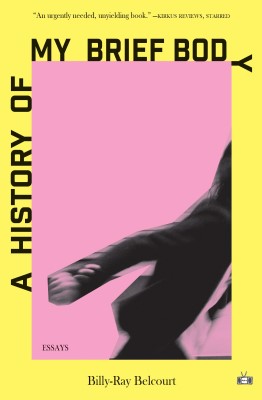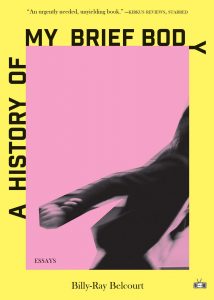
The Indigenous Literature Reading Group met on December 11th to discuss Billy-Ray Belcourt’s latest essay collection, A History of My Brief Body (Two Dollar Radio, 2020). Dr Rebecca Macklin offers an extended review of the work and a summary of the discussion:

Cover image of Billy-Ray Belcourt’s 2020 essay collection, A History of My Brief Body
The latest book from Billy-Ray Belcourt, the prolific Cree author and youngest ever winner of the Griffin Poetry Prize, is a departure from form. As his first book of prose, A History of My Brief Body departs from Belcourt’s previously published volumes which tend to fall in the category of poetry. Yet the book is also a departure from form itself – a memoir imagined through a collection of essays, the book plays with generic and formal conventions to create something entirely new, entwining testimony with theory, moving at lightning speed from sharp, wry wit to lyrics filled with pathos.
Like many of his contemporaries who came of age in an era defined by social media (including Joshua Whitehead and Tommy Pico), the style of Billy-Ray Belcourt’s prose is confessional. Its propensity for oversharing intimate details, including semi-consensual encounters on Grindr and tense sexual health check-ups, creates an uneasy intimacy with the reader – one in which the narrator attempts to process the life experiences that cause him the most discomfort by sharing them with the reader. The result is a reading experience that is often uncomfortable. Nevertheless, his writing is, in spite of its subject matter, beautiful, retaining a poetic lucidity even amidst brutality.
Belcourt is preoccupied with the juxtapositions in our world, the predominance of social media in our lives – the omnipresence of Facebook, Grindr – and how it shapes our social interactions and our relations. In contrast to the transience of digital archives is the body – an enduring, corporeal archive that acts as a repository not only for individual acts of harm and self-destruction but, too, which is shaped by historical forces and forms of inequality. History, for Belcourt, is inescapable: “like a layer of dust on everything, so granular it encases me” (26).
Belcourt’s confessional style is also a response to the proclivity for Indigenous testimony in Canada, following the Truth and Reconciliation Commission that took place from 2008-2015. The purpose of the TRC was to document the history and lasting impacts of the Indian Residential School System on First Nations, Métis and Inuit peoples – a process that was dependent on the testimony of former students and their families. The legacies of this process inform the urgent sense of testimony that comes through Belcourt’s writing – a simultaneous need to bear witness to colonial violence and a deep distrust of the settler colonial state and its neoliberal emphasis on a politics of recognition.
As a queer, Indigenous youth, multiple histories of violence intimately shape Belcourt’s life. Canadian settler colonialism – its past and irreconcilable present – as well as the history of the AIDS crisis in North America are two that Belcourt negotiates through these essays.
Threaded through Belcourt’s book is an awareness of the considerable and various forms of bodily harm that threaten Indigenous bodies in the settler state of Canada. In the opening essay, Belcourt reminds his grandmother that Indigenous people continue to be killed: “Nôhkom, I’m not safe. Canada is still in the business of gunning down NDNs.” (5) Police brutality is one of Belcourt’s driving concerns, something that impacts both Indigenous and Black communities in Canada. But settler colonialism reaps harm in a myriad of other ways, too. State violence, Belcourt writes, “commonly manifests as a short-circuited life”.
Longevity is not something that can be taken for granted when 61 First Nations communities are without clean running water; when the issue of Missing and Murdered Indigenous Women, Girls and Two-Spirit Persons (MMIWG2S) has reached “epidemic proportions”; when there is a youth suicide crisis among Indigenous communities across Canada.
The brief body invoked in the book’s title is, perhaps, a marker of Belcourt’s remarkable youth – at just 26, he has accomplished more than many writers do over their entire careers. But it also reminds us of the impermanence of corporeality. While this is a universal truth, it nevertheless cannot be separated from the intersecting forms of precarity that configure Indigenous experiences.
At times, the weight of these histories feels insurmountable: “I don’t subscribe to the fantasy of self-sovereignty, knowing fully that the past starts into my brief body like a knife. My hands are made up of a set of hands that puppeteer me. The hands aren’t God’s. They are History’s. Its sores are mine” (26). And yet, this is not the end of the story. Belcourt claims joy for himself and for others, asserting that: “Joy is art is an ethics of resistance” (8). Joy becomes a path of resistance for Indigenous peoples following the genocidal system of residential schools: “those death-schools that made happiness into a rotted thing” (44).
This rallying cry for resistance is not limited to Indigenous peoples. Rather, Belcourt extends this to all of those who are Black, queer, gendered and otherwise oppressed or minoritized by the settler state. Belcourt is clear that the violence to which he bears witness is not exclusive to Indigenous people and he aligns himself with other groups. Notably, this is something he achieves through his original and self-reflexive citational practice. By creating a dialogue with radical Black scholars (Christina Sharpe and Fred Moten), queer theorists (José Esteban Muñoz and Lee Edelman), and feminist thinkers (Judith Butler and Maria Puig de la Bellacasa), Belcourt situates Indigenous theory in relation to these other approaches. The result is an assertion that these struggles are irrevocably entwined.
According to Belcourt, to be Indigenous is to inherit the trauma of settler colonization, but it is also to inherit other ways of being, knowing, and living that offer avenues for escape and perhaps even utopia. Through Belcourt’s writing we understand that if “utopia” is to come about, it will not happen as a result of tribal nationalism or even through pan-indigeneity. Rather, Indigenous ethics of kinship and caretaking must be acted upon, to join arms with all of those who suffer at the hands of the settler colonial state and the heteropatriarchal (even homonormative) norms that it reproduces.
Dr Rebecca Macklin is Mellon Postdoctoral Fellow at the Penn Program in Environmental Humanities. She writes on Indigenous studies, the environmental humanities and Native American literatures. She recently published an article in Interventions entitled, ‘Natural Violence, Unnatural Bodies: Negotiating the Boundaries of the Human in MMIWG Narratives’. You can find her on Twitter at @rebeccamacklin_